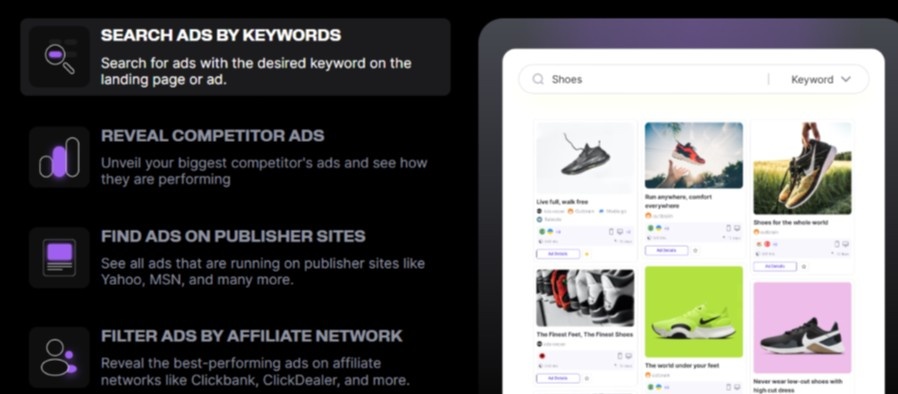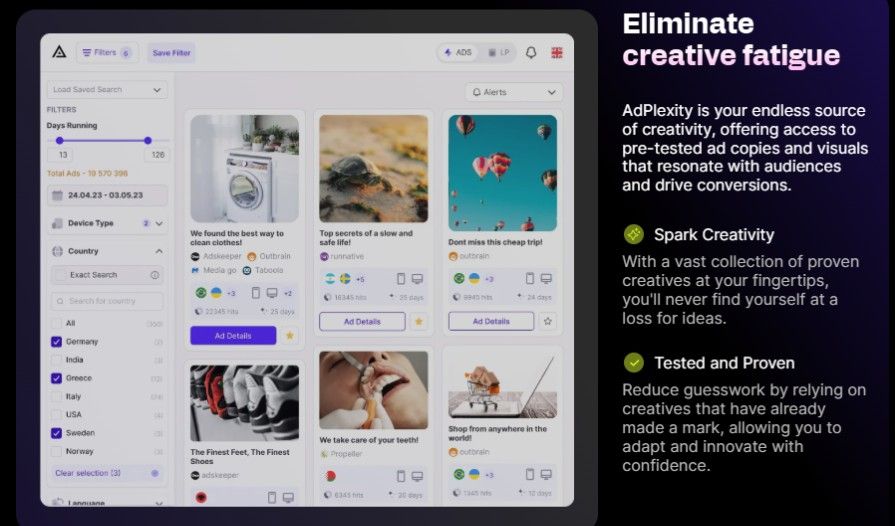After spending countless hours analyzing unsuccessful campaigns and testing different spy tools, I discovered that AdPlexity transformed my approach to campaign research and optimization.
As someone who has been in digital marketing for years, I can confidently say that having reliable intelligence about what’s working in your market is crucial for success.
In this guide, I’ll share my hands-on experience with AdPlexity and show you exactly how to use it to launch profitable campaigns faster, avoid common pitfalls, and scale your success.
Why Do Most Campaigns Fail?
Through my experience working with numerous marketers, I’ve observed that campaigns typically fail due to three main reasons:
Poor Market Research
Many marketers jump into campaigns without understanding what’s already working in their niche. I’ve seen countless cases where advertisers waste thousands of dollars testing unproven approaches when successful models already exist.
AdPlexity helped me overcome this by providing detailed insights into successful campaigns, saving me thousands in testing costs.
Inefficient Testing
Without proper competitive intelligence, marketers often test too many variables simultaneously. I remember burning through my early budgets because I was essentially shooting in the dark.
With AdPlexity’s competitive analytics, I began using placement-specific insights and engagement signals, which cut my optimization time by 60% and dramatically improved test targeting.
AdPlexity no longer offers a free trial. Instead, they now offer a 1-day risk-free money-back guarantee, which lets you try any plan and request a refund within 24 hours if unsatisfied.
Wrong Traffic Sources
Choosing the wrong traffic source can doom even the best offers. I’ve learned that success often comes from knowing exactly where your competitors are finding profitable traffic.
Once I started using AdPlexity’s analytics, I could focus my testing on proven approaches, cutting my optimization time by 60%.
Poor Ad Creatives & Messaging
Before discovering AdPlexity, I struggled with creating compelling ad creatives and messaging that resonated with my audience. I wasted countless hours and resources on ineffective ads that didn’t convert.
With AdPlexity’s creative analysis tools, I could study successful ad patterns and adapt them to my campaigns, leading to a 45% improvement in my click-through rates. The platform helped me understand which visual elements and copy approaches were driving actual conversions in my niche.
Strategies to Launch Profitable Campaigns Using AdPlexity: Step-by-Step Guide
When I first started using AdPlexity, I was overwhelmed by all the data available. Having a structured approach helped me turn that data into actionable insights.
Besides, if you are just starting out on the platform, you can save 30% on all AdPlexity plans. This will help kickstart your campaigns with huge savings:
This guide combines my personal experience with proven strategies that work for both beginners and advanced users.

Step-by-Step Process To Launch Profitable Campaigns Using AdPlexity
After analyzing hundreds of successful campaigns, I’ve developed this proven process:
Step 1: Find Winning Ads in Your Niche
I spent weeks testing random approaches, struggling to find winning ads. However, after using AdPlexity, I was able to locate proven winners in just a few hours. This significantly reduced my initial testing budget by 70%, allowing me to focus on scaling profitable campaigns.
One of my key success strategies was setting the date range between 14-30 days to identify currently profitable campaigns that had already passed the initial testing phase. I also used advanced filters to refine my search based on target geography and device type.
By focusing on ads that had been running consistently, I could spot those with strong profitability. Additionally, I paid close attention to ads with high impression counts, as they indicated strong engagement and effectiveness.
Step 2: Analyze Competitor Strategies
I used to rely on guesswork when trying to understand competitor tactics, but that approach was inefficient and costly. The real breakthrough came when I started analyzing detailed placement and bidding data.
To refine my approach, I studied ad placement strategies across different networks to identify where top-performing ads were positioned for maximum visibility. I also examined seasonal trends and timing patterns to determine the best periods for running campaigns. Analyzing competitor bidding strategies through traffic volume data gave me valuable insights into budget allocation.
Additionally, reviewing how competitors adapted their campaigns over time helped me fine-tune my own.
Pro Tip: I focus on campaigns that have been running consistently for over two weeks—these are usually profitable and provide a strong foundation for scaling.
Step 3: Extract & Modify High-Performing Creatives
I used to create ads from scratch, which was time-consuming and often hit-or-miss. However, by leveraging AdPlexity’s built-in tools, I could download top-performing ad designs and analyze key elements such as color schemes, layouts, and call-to-action patterns.

This method allowed me to create effective variations while preserving the core elements that drive engagement. Additionally, testing multiple versions of successful creative approaches helped refine my strategy even further.
Step 4: Optimize Landing Pages
I used to rely on random testing of page elements, which often led to inconsistent results. But after shifting to a data-driven optimization approach, I saw a significant improvement.
By studying competitor landing page structures, I identified key elements that made them effective. I also analyzed loading times and mobile optimization to ensure a smooth user experience. Reviewing conversion elements and their placement helped me understand what drives higher engagement.
Step 5: Select the Best Traffic Source
At first, I struggled to determine which ad networks would deliver consistent results. To solve this, I started analyzing performance data to identify the most reliable platforms. I also compared costs across different networks to ensure I was getting the best ROI.
Beyond just pricing, I focused on traffic quality by examining engagement metrics, which helped me filter out low-performing sources. Finally, I made it a priority to test multiple traffic sources, allowing me to diversify my campaign and reduce dependency on a single platform. This approach not only improved stability but also maximized my overall campaign success.
Step 6: Launch & Monitor Your Campaign
When launching a campaign, I always start with small tests to validate my assumptions before going all in. This helps me minimize risk and gather valuable insights early on. Once I see positive results, I scale gradually, using performance data to guide my decisions rather than making blind guesses.
I also keep a close eye on competitor strategies, adjusting my approach as needed to stay ahead. Most importantly, I continuously optimize based on real-time performance metrics, ensuring that my campaigns remain profitable and competitive.

Strategies to Maximize Campaign Profitability
In my years of campaign optimization, I’ve discovered that success comes from combining data-driven insights with strategic execution. Here’s how you can maximize your campaign performance:
How to Find Evergreen Campaigns & Profitable Niches
To find long-lasting, profitable campaigns, I track those running for over 30 days as they signal stability. I focus on offers with steady traffic, ensuring consistent demand.
Niches with multiple successful advertisers indicate a strong profitability, so I pay close attention to them. Studying seasonal trends also helps me prepare for market shifts and stay ahead of competitors.
Mastering Competitor Research
Understanding competitors has helped me improve my campaigns significantly. I analyze how often their ads appear and where they are placed to see what works.
Studying their creative variations and testing cycles gives me insight into their strategies. I also track how they optimize landing pages and adjust bids, allowing me to stay competitive and refine my approach.
Optimizing Your Ad Creatives For Higher Engagement
To boost engagement, I test multiple variations of successful ad angles instead of sticking to one approach. I tweak creatives for different demographics to ensure they resonate with the right audience.
Tracking engagement across devices helps me spot trends, and systematic A/B testing allows me to refine and improve my ads over time.
Landing Page Optimization Secrets
A well-optimized landing page makes a huge difference. I prioritize mobile-friendly designs since most traffic comes from mobile users.
Clear call-to-action buttons ensure visitors take the next step easily. Fast-loading pages prevent high bounce rates, and testing different layouts helps me find the most effective design for conversions.
Scaling And Automating Campaigns for Maximum ROI
Scaling campaigns requires a strategic approach. I gradually increase budgets based on performance to avoid overspending.
Testing new traffic sources helps diversify reach, while automated bid management systems optimize spending in real-time.
Refreshing creatives every 10–14 days, especially in fast-moving verticals like health or ecommerce, helps maintain click-throughs and prevents ad fatigue.
Who Should Use AdPlexity?
After working with various marketers, I’ve identified these primary user groups that benefit the most from AdPlexity:
- Affiliate Marketers seeking profitable campaign insights
- Media Buyers looking to optimize their ad spend
- Digital Marketing Agencies need competitive intelligence
- E-commerce Businesses wanting to improve their ad performance
- Start-up Marketers learning market dynamics
- Experienced Advertisers scaling their campaigns
Key Features Of AdPlexity
Through extensive testing, I’ve found these features most valuable:
- Real-time ad monitoring across multiple platforms
- Comprehensive landing page analysis tools
- Detailed traffic source intelligence
- Advanced filtering and search capabilities
- Automated campaign tracking systems
- Landing page download functionality
- Cross-platform campaign analysis
- Historical data access for trend analysis
- Carrier & ISP filtering for mobile and broadband traffic
- Landing page preview feature
Looking to save some bucks on AdPlexity? Here are some promo codes and coupons that will help you save significantly:
You can also save significantly on the platform during Thanksgiving, Black Friday, and Cyber Monday.
Conclusion: Adplexity Turning Data into Profitable, Scalable Campaigns!
From my extensive experience with AdPlexity, it’s an essential tool for anyone serious about launching profitable campaigns. The combination of comprehensive data, a user-friendly interface, and powerful analysis tools makes it invaluable for optimizing campaign performance and reducing testing time.
Ready to transform your campaign performance? Claim your 30% lifetime discount today and start launching more profitable campaigns faster.
FAQs
AdPlexity is primarily used for competitive intelligence in digital advertising, helping you analyze successful campaigns across multiple platforms.
It helps identify profitable offers, analyze successful campaigns, and optimize your marketing strategy based on real market data.
While there’s a learning curve, the platform offers comprehensive tutorials and support for new users.
AdPlexity provides cross-platform monitoring, including desktop, mobile, native, and push notification ads.
The platform refreshes data every few minutes, providing near real-time insights about active campaigns.
